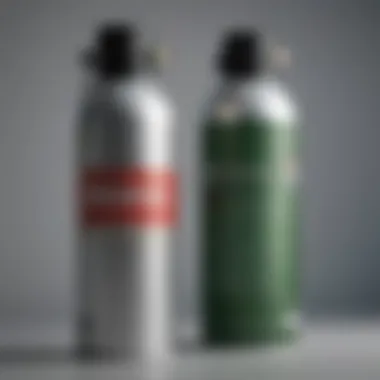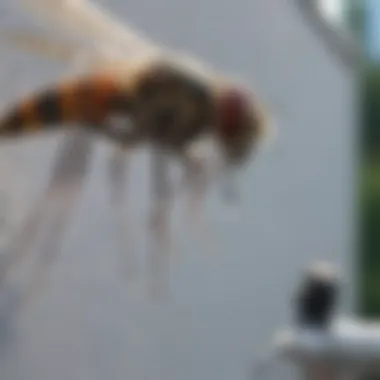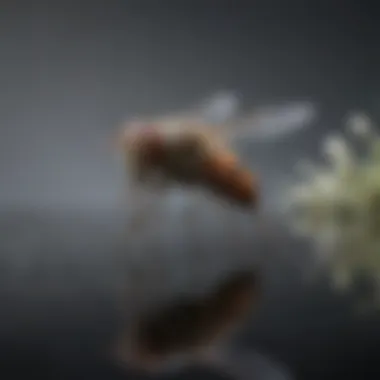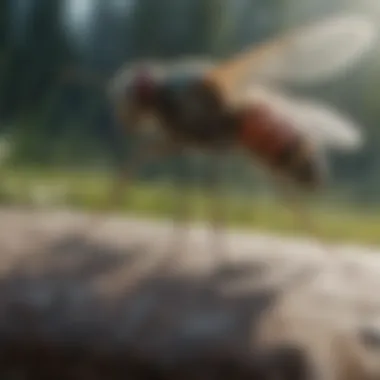PT Alpine Fly Spray: Effective Pest Control Insights


Intro
Pest management is a crucial aspect of maintaining a safe and healthy home environment. Among various pests, flies are notable due to their rapid reproduction and potential health risks they pose. Effective control methods are essential for homeowners and pest control professionals alike. This article delves into PT Alpine Fly Spray, a targeted solution designed specifically for managing fly populations. By understanding its formulation, application techniques, and impact, readers can make informed decisions regarding pest control.
Understanding Pests
Definition of Pests
Pests typically refer to organisms that are unwanted and cause harm. In the context of households, pests include insects like flies, roaches, and ants. Flies can multiply quickly and interfere with food safety, making them a primary concern for many.
Importance of Pest Identification
Identifying pests accurately is the first step in effective pest management. Each pest has different behaviors, habitats, and vulnerabilities. Understanding these factors aids in choosing the right control methods. For instance, not all flies respond to the same treatment, so identifying the species can optimize control strategies.
Prevention Techniques
Home and Garden Preventative Measures
Preventing fly infestations requires a comprehensive approach. Simple measures can greatly reduce the attraction of flies to your home:
- Regular Cleanup: Keep food and waste well-contained.
- Seal Entry Points: Check windows and doors for gaps.
- Maintain Gardens: Remove any decaying fruits or standing water.
Homeowners can create less hospitable environments for pests, thus minimizing infestations.
Seasonal Prevention Tips
Flies are often more active during warmer months. Adjusting your prevention tactics seasonally can provide significant benefits:
- Spring Cleaning: Deep clean spaces that may attract flies.
- Summer Maintenance: Use screens on windows to inhibit entry.
- Fall Cleanup: Organize garden waste and dispose of attractants.
Eco-Friendly Pest Control Solutions
Overview of Sustainable Practices
Sustainable pest control emphasizes methods that minimize harm to the ecosystem while effectively managing pests. Integrated Pest Management (IPM) is a popular strategy, involving a blend of biological, cultural, and chemical controls. This holistic approach considers long-term pest management strategies without relying solely on chemical controls like PT Alpine Fly Spray.
Natural Remedies and Their Effectiveness
Many homeowners seek natural alternatives to chemical sprays. Some popular options include:
- Essential Oils: Some, like eucalyptus and peppermint, can deter flies.
- Traps: Homemade traps using vinegar or sugar can attract and capture flies.
- Repellents: Certain plants like basil and lavender may help repel flies.
While these methods can provide some relief, their effectiveness varies and may not suffice in severe infestations.
"Understanding the specific behaviors of pests is crucial for optimal management strategies."
Ending
This article aims to shed light on the use of PT Alpine Fly Spray while discussing the wider context of pest management. By understanding pests, employing prevention techniques, and exploring alternative solutions, households can tackle fly infestations effectively. Readers will gain a comprehensive insight that empowers them in their pest management choices.
Foreword to PT Alpine Fly Spray
Pest control is a critical aspect of maintaining a comfortable and hygienic home environment. With frequent fly infestations, finding an effective solution is paramount. PT Alpine Fly Spray offers an advanced approach to tackle these persistent nuisances. Understanding this product and its application can significantly impact both residential and commercial pest control strategies.
Overview of Pest Control Solutions
In the landscape of pest management, many solutions exist, ranging from traditional insecticides to natural repellents. Traditional methods often employ synthetic chemicals. These can be effective but may come with drawbacks regarding safety and environmental impact. Natural solutions tend to favor safety but may lack efficacy. Amid these choices, PT Alpine Fly Spray provides a solution that combines effectiveness with safety, ensuring that home environments remain free from unwanted pests while minimizing harm to people and pets.
- Efficacy: PT Alpine Fly Spray is designed for specific targeting of flies, which enhances its effectiveness.
- Safety: Its formulation has been tested to ensure it poses minimal risks when used as directed, making it suitable for various settings.
- Convenience: Easy application methods add to its appeal, allowing users to manage pest problems with minimal effort.
What Sets PT Alpine Apart


PT Alpine Fly Spray distinguishes itself from other pest control solutions through its innovative formulation and delivery method. Unlike conventional sprays that often rely on broad-spectrum chemicals, PT Alpine targets specific pests directly. This selectivity not only enhances effectiveness against flies but also reduces collateral damage to beneficial insects.
Moreover, the product features a unique aerosol-based delivery system. This ensures an even distribution of the active ingredients, promoting better coverage in even hard-to-reach areas. Reviews show that users appreciate how PT Alpine can be applied in various environments, from homes to outdoor spaces.
- Targeted Action: Focused on fly control, minimizing broader ecological impact.
- User-Friendly Application: Designed for straightforward use, appealing to homeowners who need effective solutions without complex instructions.
- Advanced Formulation: Incorporates the latest in pest control technology, making it a preferred choice for both amateurs and professionals.
"PT Alpine Fly Spray not only manages fly populations effectively but also prioritizes user safety and ecological considerations."
The combination of these factors emphasizes why PT Alpine Fly Spray stands out in a crowded market. It serves as a strategic tool in a comprehensive pest management plan.
Chemical Composition
Understanding the chemical composition of PT Alpine Fly Spray is fundamental for evaluating its effectiveness and safety. The specific arrangement and interaction of its components directly impact the spray's ability to control fly populations. By dissecting both active and inert ingredients, consumers can make informed decisions about their pest control strategies.
Active Ingredients Analysis
The active ingredients in PT Alpine Fly Spray are the primary components responsible for its pest control efficacy. These substances target various life stages of flies, disrupting their normal behavior and leading to population reduction. One of the principal active ingredients is prallethrin, a powerful pyrethroid that primarily affects the nervous system of insects.
Prallethrin is known for its rapid knockdown effect on flies, meaning that they are incapacitated soon after exposure. Another significant active ingredient is imiprothrin, which complements prallethrin by delivering lasting residual control. Together, these active compounds create an efficient mechanism for hoevery pest control applications. Detailed studies have shown that formulations containing these ingredients offer strong performance in both households and commercial environments.
Benefits of Active Ingredients:
- Fast-acting formulation.
- Extended control against recurring infestations.
- Minimal odor during and after application.
Inert Ingredients and Their Roles
Inert ingredients, though not classified as active agents, play significant roles in the overall effectiveness of PT Alpine Fly Spray. These components enhance the stability, application, and distribution of the active ingredients. An important inert ingredient is solvent, which helps dissolve the active components and improves the spray's spreadability.
Another example is surfactants, which reduce surface tension, enabling the spray to adhere better to surfaces and carry active ingredients more effectively. This promotes a more uniform application that can cover larger areas without requiring excessive product use.
Roles of Inert Ingredients:
- Improve product stability and shelf-life.
- Enhance the efficacy of active ingredients through better distribution.
- Contribute to user-friendliness by improving spray characteristics.
"Inert ingredients are integral, as they ensure that the active ingredients work effectively and safely in various applications.
Overall, a thorough understanding of the chemical composition of PT Alpine Fly Spray, including its active and inert ingredients, empowers users to optimize pest management practices in their environments.
Mechanism of Action
Understanding the mechanism of action for PT Alpine Fly Spray is crucial for both homeowners and pest control professionals. This term refers to how the product effectively interacts with the target pests—in this case, flies. A clear grasp of this mechanism can help users make informed decisions about pest management strategies. Knowing how a product operates enables users to tailor their applications for optimal results and contribute to better pest control outcomes.
How PT Alpine Targets Flies
PT Alpine Fly Spray employs a unique formulation designed specifically to annihilate fly populations. The active ingredients include potent insecticides that disrupt the nervous system of flies upon contact, leading to rapid paralysis and death. The product utilizes a microencapsulated technology, allowing for sustained release over time. This approach maximizes efficacy, ensuring that flies are effectively managed.
- Contact Insecticide: Upon direct contact, the powerful ingredients penetrate the insect's exoskeleton, causing immediate harm.
- Residual Effect: The microencapsulation technology provides lingering protection, reducing the need for frequent applications.
This targeted action ensures that PT Alpine does not just repel flies but actively works to eliminate them from the treated areas.
Effect on Fly Life Cycle
In addition to targeting adult flies, PT Alpine Fly Spray has implications for the entire life cycle of flies. By addressing not just adult flies but also larvae and eggs, it helps to reduce future populations significantly.
- Larvicidal Properties: Some components within the spray inhibit larval development, preventing them from reaching maturity.
- Broader Impact: This dual-action—affecting both adults and larvae— contributes to a more comprehensive control strategy.
"Understanding the life cycle of fly species can enhance the effectiveness of PT Alpine Fly Spray in long-term pest management."
Application Methods
Understanding the application methods of PT Alpine Fly Spray is vital for achieving optimal pest control results. Proper techniques not only enhance the product's effectiveness but also ensure safety for users and the environment. This section outlines the recommended application techniques, the necessary frequency of application, and highlights crucial safety precautions to follow.
Recommended Application Techniques


For effective use of PT Alpine Fly Spray, it is imperative to follow the recommended techniques. The following methods are advisable for both indoor and outdoor applications:
- Direct Spray Method: Point the spray nozzle towards the target area. Ensure that the spray coats surfaces evenly.
- Surface Treatment: Apply the spray on surfaces where flies are likely to land. Common areas include windowsills, doorways, and under furniture.
- Aerosol Application: For larger areas, the aerosol version may be preferred. Hold the can upright and spray in a sweeping motion, allowing the mist to cover the area adequately.
Using these techniques appropriately increases the likelihood of deterring flies effectively. It is also recommended to consult the product label for specific instructions tailored to your setting.
Frequency of Application
The frequency of applying PT Alpine Fly Spray is crucial for maintaining its efficacy. Typically, the recommendation is to apply every two to three weeks, depending on the level of infestation and environmental conditions. External factors can influence how often treatments should occur:
- High Fly Activity: In areas with significant fly populations, more frequent applications may be warranted.
- Temperature and Weather: Rain or extreme temperatures may reduce the product's effectiveness, necessitating reapplication sooner.
Monitoring the fly population can help in adjusting the application frequency accordingly. Regular observation allows for better management of the pest control program.
Safety Precautions During Application
Safety should always be a priority when using fly spray. Here are essential precautions to consider:
- Personal Protective Equipment (PPE): Wear gloves, goggles, and a mask to minimize risk during application. This prevents skin contact and inhalation of spray mist.
- Ventilation: Ensure that the area is well-ventilated, particularly during indoor applications. Open windows and doors to help disperse the spray.
- Keep Away from Food: Avoid applying near food, food preparation areas, or where pets may ingest the product. Ensuring the area is clear before application is critical.
Following these precautions can significantly reduce health risks associated with PT Alpine Fly Spray.
By adhering to the recommended application methods, adjusting frequency based on conditions, and observing safety precautions, users can maximize the benefits of PT Alpine Fly Spray while ensuring a safer environment.
Efficacy of PT Alpine Fly Spray
Understanding the efficacy of PT Alpine Fly Spray is crucial for homeowners and pest control professionals alike. Efficacy refers to the ability of a product to perform its intended purpose. In the case of PT Alpine, this involves the effective management of fly populations. Flies can be more than just a nuisance; they can carry diseases and contaminate food sources. Therefore, knowing how effective this spray is can help in making informed decisions.
Field Studies and Results
Field studies on PT Alpine Fly Spray provide valuable insights into its performance in real-world situations. Research often focuses on metrics such as the time to knockdown, which is the duration it takes to incapacitate flies after application. Results from several studies suggest that PT Alpine exhibits rapid action against flies. Studies show a significant reduction in fly populations within a 24-hour period post-application.
Another important finding is that PT Alpine maintains its efficacy over extended periods. This factor is essential for homeowners who may prefer fewer applications, thereby lowering the overall cost and effort involved in pest management.
"Efficacy in pest control not only reflects immediate results but also long-term results, maintaining a fly-free environment."
Comparison with Other Pest Control Products
When evaluating PT Alpine, it’s also important to compare it with alternative pest control products on the market. Different products use various active ingredients, leading to differences in effectiveness. While some sprays may incapacitate flies quickly, PT Alpine's formulation shows lasting effects that can reduce the overall fly population more effectively.
For instance, some competitors rely solely on pyrethrins, while PT Alpine combines them with other ingredients to enhance performance and longevity. Customers report that the combination approach minimizes the risk of flies developing resistance, a common concern in pest management.
Additionally, consumer feedback often highlights the ease of use and effective dispersal of PT Alpine. In contrast, some other products require more elaborate application techniques or frequent reapplication, which could be inconvenient for users. Overall, PT Alpine demonstrates a favorable profile compared to other options, proving its worth in fly management.
Environmental Impact
Understanding the environmental impact of PT Alpine Fly Spray is critical. In contemporary pest management, the methods we choose to control pests can have significant repercussions for our ecosystems. This section focuses on the implications that arise from the use of such insecticides, discussing both their effects on non-target organisms and how they fit into broader ecological considerations.
Assessment of Ecotoxicity
Ecotoxicity refers to the potential harm that chemical substances can cause to living organisms and their environment. When assessing the ecotoxicity of PT Alpine Fly Spray, it is important to analyze its active and inert ingredients. Studies show that the product contains components that are specifically formulated to target flies while minimizing harm to other species.
- Beneficial insects, such as bees and ladybugs, are less likely to be affected by the targeted application of PT Alpine. This is an important aspect, especially for homeowners wishing to maintain a balanced garden ecosystem.
- Comparative studies indicate that many conventional fly sprays can harm fauna other than pests. Therefore, PT Alpine's careful formulation offers a significant advantage, allowing for pest control without widespread damage to the environment.
However, thorough testing and understanding of the product's behavior in various environmental conditions must be ensured. It is essential to consider factors that influence how the product breaks down after use, and whether any residual effects could accumulate in the environment.
Sustainable Pest Control Considerations
Integrating PT Alpine Fly Spray into a sustainable pest management strategy is crucial. Sustainable practices not only focus on effective pest control but also emphasize maintaining environmental health. One approach includes using PT Alpine in combination with other pest control methods, creating a more holistic strategy.
- Integrated Pest Management (IPM): Homeowners can use PT Alpine alongside non-chemical methods, like traps and natural predators, to enhance effectiveness and reduce dependency on chemical solutions.
- Timing and Localization: Applying the spray during specific times and targeting infested areas can minimize unnecessary exposure to surrounding flora and fauna.
Additionally, continuous education on pest control alternatives and the long-term consequences of chemical use helps empower homeowners. Choosing environmentally friendly methods and remaining informed about emerging best practices can enhance sustainability in pest management.


"Sustainability in pest management is not just about reducing chemicals; it’s about enhancing ecosystem health and achieving balance."
Safety Considerations
Understanding safety considerations is vital when discussing the use of PT Alpine Fly Spray. This section will address the importance of evaluating potential risks associated with the product, especially for households with pets and children. Awareness of safety guidelines ensures that users can effectively minimize risks and maximize benefits when using fly spray.
Health Risks for Humans and Pets
PT Alpine Fly Spray, like any other pesticide, carries health risks if not used properly. It is essential to recognize that the primary active ingredients can be harmful if ingested, inhaled, or come into contact with skin. Specific health risks include:
- Respiratory Issues: Inhaling spray mist can cause irritation to the respiratory system. Individuals with asthma or other pre-existing respiratory conditions should exercise caution and preferably avoid exposure during application.
- Dermatitis: Direct skin contact with the spray may result in allergic reactions or irritation. It is wise to wear protective gloves and long sleeves to minimize skin exposure.
- Impact on Pets: Pets can also be sensitive to the chemicals in fly spray. Cats and dogs may experience adverse reactions if they ingest the product or come into contact with treated areas soon after application.
The U.S. Environmental Protection Agency (EPA) states that proper use and handling of pesticides are critical in minimizing health risks while achieving effective pest control.
To safeguard the well-being of both humans and pets, adherence to precautionary measures is paramount. Reading the label instructions carefully and following recommended safety protocols will reduce health risks significantly.
Emergency Procedures and First Aid
In the unfortunate event of exposure to PT Alpine Fly Spray, it is crucial to know the emergency procedures and first aid steps to take. Awareness of these procedures can potentially alleviate any adverse effects quickly and efficiently. Here are the main steps:
- Inhalation: If a person has inhaled the spray, they should be moved to fresh air immediately. Monitoring for breathing difficulties is essential. If symptoms persist, seek medical attention promptly.
- Skin Contact: Remove any clothing contaminated with the spray. Wash the affected skin area with soap and water thoroughly. If irritation continues, contact a healthcare professional.
- Eye Exposure: If the spray gets into the eyes, flush them with plenty of clean water for 15-20 minutes. Remove any contact lenses if applicable, and seek medical assistance if irritation persists.
- Ingestion: If the product has been ingested, do not induce vomiting. Instead, contact poison control or seek medical help immediately. Having the product container available can assist medical professionals in providing proper care.
Following these procedures can play a crucial role in ensuring safety for users and their families; knowledge is key.
Providing attention to safety considerations when using PT Alpine Fly Spray ensures effective pest management while protecting the health of every household member.
Alternative Pest Control Methods
The significance of alternative pest control methods cannot be overstated, especially in the context of integrated pest management. While PT Alpine Fly Spray provides a targeted approach to managing fly populations, exploring alternatives can offer broader strategies for effective pest management. This section addresses various methods, highlighting their benefits and considerations.
Natural Repellents and Their Effectiveness
Natural repellents are derived from plants and other organic materials. They offer a solution for those who prefer to manage pests without synthetic chemicals. Common natural repellents include essential oils like citronella, eucalyptus, and peppermint. These substances disrupt the pests’ sensory mechanisms, making the environment less attractive to flies and other insects.
Effectiveness of Natural Repellents:
- Environmental Safety: Natural repellents generally pose minimal risk to non-target species, including beneficial insects.
- Sustainability: As these products are derived from renewable resources, their use aligns with sustainable practices.
- Health Considerations: Many homeowners and pet owners favor natural options due to reduced toxicity concerns.
- Limitations: However, the effectiveness of these repellents can vary significantly. Factors such as concentration, application frequency, and specific fly species may affect outcomes.
In summary, while natural repellents can be effective in controlling fly populations, they are often better suited for preventive measures rather than direct elimination.
Integrated Pest Management (IPM) Strategies
Integrated Pest Management (IPM) combines biological, cultural, and chemical control methods to manage insect populations sustainably. Key elements of IPM include:
- Monitoring and Identification: Regularly assessing pest populations helps determine the necessity of control measures.
- Prevention: Employing techniques such as sanitation and habitat modifications reduces the likelihood of infestations.
- Control Methods: This may involve using PT Alpine Fly Spray among other solutions or leveraging biological controls such as beneficial insects that prey on pests.
Benefits of IPM Strategies:
- Cost-Effectiveness: Long-term pest management strategies can reduce costs associated with frequent pest treatments.
- Reduced Chemical Dependency: Minimizing the reliance on chemical pesticides lessens environmental impact and promotes a safer atmosphere for humans and pets.
- Long-Term Effectiveness: Sustainable practices ensure that pest populations do not develop resistance, making control methods more effective in the long run.
By adopting IPM strategies, homeowners can address pest issues in a comprehensive manner that aligns with their values and environmental concerns.
Culmination
In discussing PT Alpine Fly Spray, it is crucial to understand its significance as a pest control solution. This article is aimed at educating homeowners and pest control professionals alike about the product's chemical makeup, effectiveness, and optimal application techniques. The section serves to encapsulate the overarching themes that have emerged throughout the piece.
Summarizing the Benefits of PT Alpine Fly Spray
PT Alpine Fly Spray offers several compelling advantages:
- Targeted Efficiency: Designed specifically for flies, it effectively reduces their populations, preventing infestations.
- User-Friendly Application: The spray can be used in various settings, making it ideal for domestic environments as well as professional pest control.
- Quick Action: Many users report immediate results, showcasing its efficacy in controlling fly presence.
- Safe Chemical Profile: Its formulation is designed to minimize health risks, making it suitable for households with pets.
The significant benefits of PT Alpine Fly Spray make it a preferred choice among pest control options.
Final Recommendations for Use
While PT Alpine Fly Spray is effective, some recommendations should be highlighted to ensure the best results:
- Follow Instructions: Always adhere to the manufacturer’s guidelines for application to maximize efficacy and safety.
- Regular Monitoring: Check areas for fly activity frequently to determine if additional treatment is necessary.
- Consider Environmental Factors: Be aware of weather conditions that may influence the spray's performance, such as wind or rain.
- Combine Strategies: For optimal results, consider integrating PT Alpine with other pest control methods or natural repellents, like essential oils.



